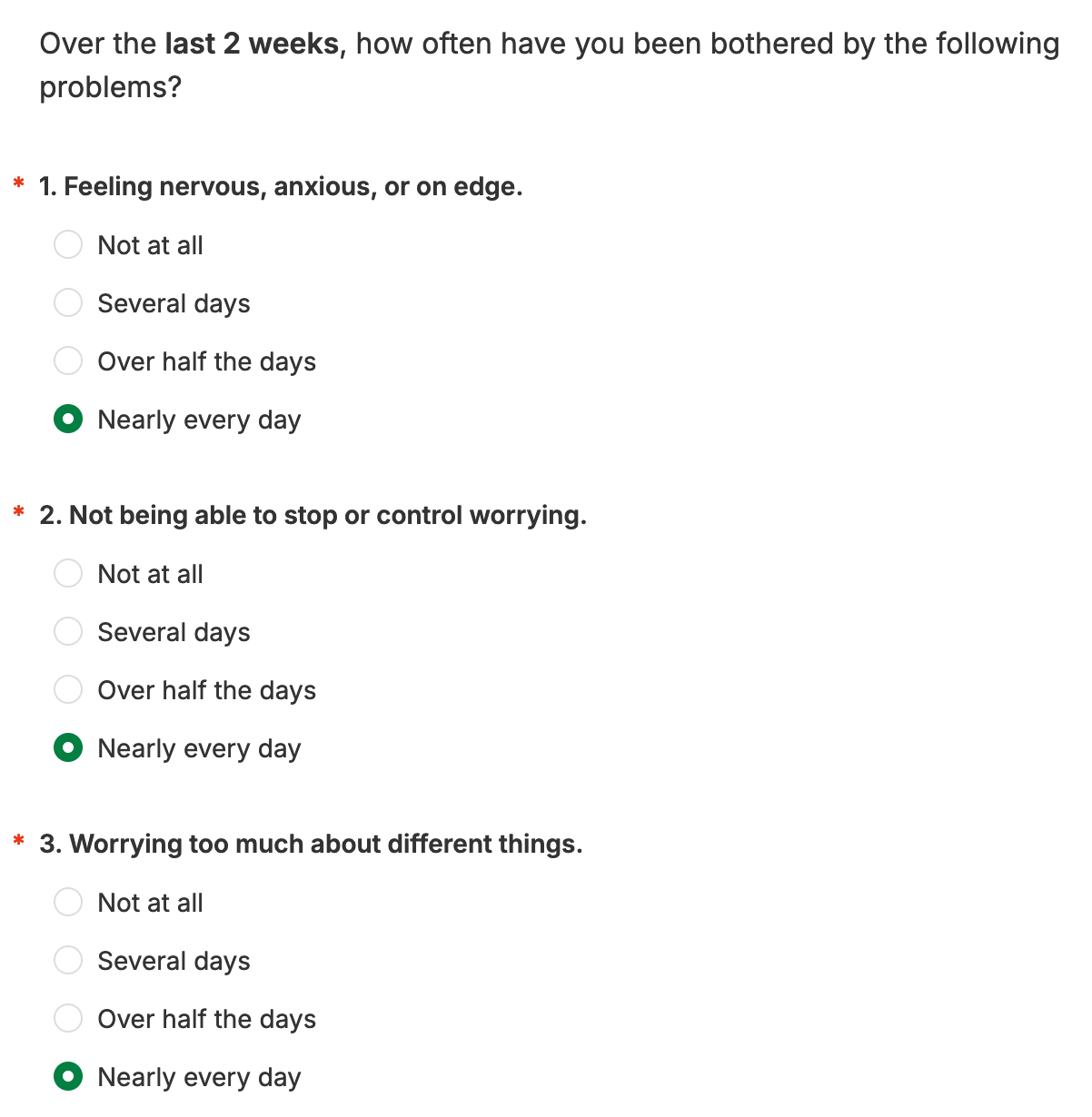It's Not Made For You
Don't let "human-centered design" fool you into thinking it is
Earlier today I was filling out some paperwork for a new therapist. My usual therapist, whom I adore, is on maternity leave, so I thought I’d take this time to work with someone else who has a different approach. Among the various questionnaires I had to fill out was the GAD-7, which measures the severity of anxiety.

Now, my mom (who reads this newsletter – hi mom!) would say that my responses aren’t unusual for me, because I am a person who in general worries too much. Whether that’s true or not (probably true), I can definitely say that the past two weeks I have felt a near-constant state of anxiety. Maybe you have too!
I briefly touched on this last week, but I bring it up again because I want to talk about it in the context of technology and mental overload. There’s a lot of writing out there about feeling overwhelmed, about how much we truly need to know or can even deal with on a daily basis, about how humans simply aren’t designed to experience the sheer magnitude of catastrophe, despair, atrocity, and fear that we’re constantly exposed to. I’m not even sure if we’re designed to experience the magnitude of information period, whether positive or negative.
But you know what other experience isn’t designed for this moment we find ourselves in? The tools and platforms we use every single day. This isn’t news, because we’re all very aware of it – especially the harm caused by social media and the increased enshittification of every platform and service we use. But I’m talking about something fundamental, beneath those big issues. I mean that these tools are literally not designed for the kind of human-level experience most of us are looking for.

That’s a big fucking assertion to casually toss out, so let me break it down as simply as I can:
The tools you use to engage with the world, connect with people, learn about the news, and generally be a person in our modern society are not designed for you. At least, they are not designed with your actual best interests at heart. They are designed for you certain ways, but those ways are almost always in service of something much more important. The industry has gone out of its way to convince itself and everyone else that the “end user” - the customer – is paramount. The entire idea of “user-centric design” emerged for this very reason, a practice that allowed companies to showcase how they focus on designing for the people who use the product, rather than build solely for business needs or solely based on the “gut instinct” of that one product manager who thinks he’s a product genius.
And sure, the user is considered as a consideration of the design process. It’s important to know user behavior, context, interest, need, and so on. If people don’t like or won’t use the feature you build, it’s a waste of valuable resources. Worse, if they hate the feature or product change, it might tank crucial metrics the company needs to ultimately show a continued level of profitability.
But at the end of the day, whatever a for-profit tech company does with the product it creates (especially a company funded by venture capital), it does not do it for you. Not to improve your lives, not to help you stay closer to your friends, not to make sure you say informed about the most important events happening around you. The company does this for the company, and for its shareholders. You might think you know this, but I want you to understand it on a specific level:
Every feature they choose to build and every feature they don’t choose to build is predicated on this desired outcome. So the features they build that you love? Those are helping their business goals and metrics. The features they don’t build that you swear you need? They’re not building them because either the features won’t help business goals and metrics, or because they might inadvertently harm the metrics that matter most at any given time.
Everything you use on a platform like Instagram, X, Facebook, Snapchat, even Substack exists ultimately to benefit the company. It’s hard to remember that because so much of what we do on these platforms is, in large part, disconnected from the actual company that builds it. It’s not like using electricity and then paying for it, or shopping at a department store. In many cases, the product – the thing you buy or consume – and the infrastructure that creates and supports the product are deeply intertwined. But in this new era of platforms, that’s not really the case. The platform creates the tools and the infrastructure to support everything that goes on in the product, but the actual thing you buy or consume? That’s made by us.

This is one of those concepts that I find to be both blindingly obvious and insanely complex. It’s very “yes duh” and “oh my god there’s so much to say here, where do I even begin.” I like to keep these newsletters relatively manageable in size (I want paid subscribers – to whom I am eternally grateful – to feel like they kinda get their money’s worth but I also don’t want to write so much that you don’t have time to read it all), so I will try to address more of this in future installments, as well as in the eventual book I’m working on. But I know there are a lot of people out there who, while they use tech all the time, don’t really understand much about it. I know that feels weird or embarrassing to admit, because the whole world is tech and it seems obvious to a lot of other people, so what’s wrong with you? Why can’t you figure it out? Nothing is wrong with you. Like I always say, if technology makes you feel dumb, that’s on the people who made it. Tech should never make an end user feel dumb.
Anyway, before I get too far off track: We are all operating on platforms that are designed with a different set of tools than we frequently would like. The tools we have on most social media platforms are rudimentary at best. Big thuddy clubs we can use to whack a few moles or shut ourselves away, like blocking, muting, or creating a private account. We can sort of modulate the information that comes our way by, like, taking a social media break. Or unfollowing some accounts. Or creating a list of accounts we don’t follow but visit for specific information. Even in some of our most regularly used apps, where we keep in steady contact with friends and coworkers, we have very limited tools for managing information and keeping on top of all the things we have to do.
It’s easy to talk about how much of all this stuff we should expose ourselves and our children to on a daily basis, or to give each other permission for taking breaks. It’s obviously much harder to take those breaks. But hardest of all is finding any sort of middle ground, any human way of connecting, engaging, interacting, consuming. Why are the choices we have around all of this so black or white? Block or follow, use social media or quit it for a month. It’s not because we’re too dumb or incapable of using any of it in a more reasonable, sustainable way but because we are not given the tools to do so. We are given firehoses of news, videos, photos, songs, sounds, and more, and then we’re made to feel bad for how bad all of it makes us feel because somehow we’re not strong enough to withstand the onslaught or just turn the firehose off.
A lot of the anxiety I’ve felt lately has clearly been exacerbated by the time I spend online, whether reading Reddit, doing a quick glance at Instagram, or perusing Bluesky. The surge in feeling is so immediate, like my blood pressure spikes as soon as I open any of these apps. So I try not to but then I think: How do I make sure I’m staying informed? How do I keep connected with other people, friends and acquaintances who I mostly talk to on one or another of these platforms? How do I share my own writing and ask others to help me share it too? I’m torn between two rough options – use it or don’t – and neither one is great. In fact, they’re both terrible in different ways. My work, my engagement with culture, my ability to learn about current events, and many of my friendships are heavily dependent on these platforms. Some are so deeply embedded in them that they’re siloed. If I lose that platform, I know I will lose that friend. Yet where are the tools to manage any of this, or to make my experience more human? They don’t exist. They kind of don’t have to! I think all these platforms know the price I will pay if I leave them entirely, so I’ll stick around, even if I suffer.
One of the most crucial things I learned while working in tech is that what makes an insight powerful isn’t just that it’s more than some simple data points. What makes it powerful is that it is actionable. You can do something with it. I wonder if that is partly what’s fueling our deep feeling of hopelessness lately, in particular when it comes to tech. We have so many people writing about how tech makes them feel, or giving each other permission to do a digital detox or to get mad or whatever. We have much less writing that helps you understand what you can, actually, really, effectively do.
The problem, of course, it’s that it’s hard to make any of these insights actionable because most of the product we use are built by companies who, as you know, need to care more about themselves than they care about any of us. So what kind of action can we conceivably take? How do we navigate this beyond detoxing, or cutting ourselves off, or setting time limits and using our friends as accountability partners?

I’ve also been thinking about this because, as I mentioned, I am moving off Substack. It’s taking a little while because I’ve decided to not only move to another newsletter/blog service, I’m also going to set up at my own domain so my newsletter is connected to my own website. But this requires a bit of work. More than that, it requires work that isn’t straightforward. I am pretty tech savvy, and I’ve build entire websites in the past, but some of the work required to migrate the substack and set up my new site is more than I want to take on right now. And if it’s more than I want to take on, it’s going to be way, way beyond the ability of the vast majority of people who just want to come online to read some stuff and post a photo of their dog or grandchild. There’s too much friction for most people to even consider moving off any of these platforms. It’s too hard. So what else can we do?
There has to be a way for us to start to develop community resources. I think we’re all seeing the downsides of relying heavily on a single platform for one type of content or engagement. If we’re not seeing it, please tell me, because I would really love to explain it!! I have some ideas for community engagement around this that I’ll share next time. But I’d love to hear from you too: What would make you feel like you could engage online in a more human way?
Until next Wednesday.
Lx
Meets Most is a reader-supported publication. To receive new posts and support my work, consider becoming a free or paid subscriber.
Leah Reich | Meets Most Newsletter
Join the newsletter to receive the latest updates in your inbox.
